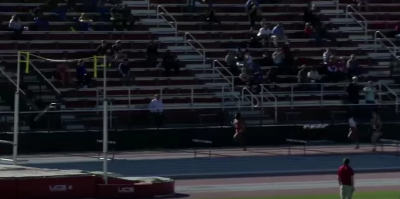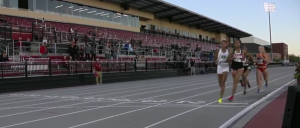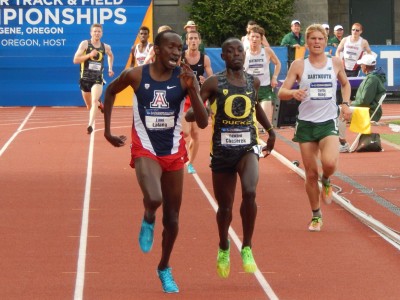WTW: Penn Still Triumphs For Collegiate Relays, Lawi Lalang is Almost a US Citizen, Jenny Simpson Has Some Work To Do
The Week That Was In Running, April 23 – April 29, 2018
by LetsRun.com
May 2, 2018
A shorter-than-normal version of the Week That Was appears below. Rojo’s paternity break ends soon and vows the WTW will be back in full force in the near future.
Past editions of The Week That Was can be found here. Questions, comments, or a tip? Please call us at 844-LETSRUN (538-7786), email us or post on our forum.
****
And The Winner In The Penn Relays, Drake Relays, and National Relay Championships Is…Penn
Last weekend was “relay weekend” at the collegiate level — normally one of our favorite weekends of the year. However, this year, the weekend wasn’t as fun as Arkansas — the same athletic program that recently thought it was a good idea to have its women’s tennis team beat Tennessee State six times on the same day so that Arkansas could become eligible for the NCAA championships — tried to hijack things and create its own meet called the “National Relay Championships” where only Power 5 schools were allowed to compete.
So which meet was the best? According to the stats, Penn was the winner in terms of collegiate relays. We compiled the winning times for the 4×100, 4×400, 4×800, SMR, DMR, and 4×1500/1600/mile at all three relays and compared them. Penn came up on top with eight wins while Arkansas had four and Drake 0.
Drake has the best individual pro events.
| A Comparison Of The Winning Times at The 2018 Penn Relays, Drake Relays, and “National Relay Championships” In Arkansas |
||||
| Penn | Drake | Arkansas | Winner | |
| Men’s 4×1500 | 15:10.71* | 15:34.98^ | 15:14.18 | Penn |
| Men’s DMR | 9:34.37 | 9:42.75 | 9:34.70 | Penn |
| Men’s 4×800 | 7:14.16 | 7:27.98 | 7:25.97 | Penn |
| Men’s SMR | 3:15.25 | 3:17.73 | 3:16.94 | Penn |
| Men’s 4×400 | 3:01.82 | 3:05.05 | 3:02.68 | Penn |
| Men’s 4×100 | 38.95 | 39.69 | 38.59 | Arkansas |
| Women’s 4×1500 | 17:35.48 | 17:56.12$ | 17:45.75 | Penn |
| Women’s DMR | 11:01.94 | 11:07.59 | 11:07.49 | Penn |
| Women’s 4×800 | 8:19.98 | 8:36.51 | 8:25.24 | Penn |
| Women’s SMR | 3:45.05 | 3:47.99 | 3:41.59 | Arkansas |
| Women’s 4×400 | 3:32.43 | 3:28.42 | 3:27.07 | Arkansas |
| Women’s 4×100 | 44.14 | 44.62 | 42.84 | Arkansas |
| Final Score | 8 | 4 | 0 | Penn 8 – Arkansas 4 – Drake 0 |
*converted from the 4 x mile time of 16:23.75, using the standard 1.0802 mile/1500 conversion.
^converted from the 4 x 1600 time of 16:49.97. We didn’t even bother to convert the 1600 to a mile first as it’s so slow. We just used the 1.0802 mile to 1500 conversion.
$converted from the 4 x 1600 time of 19:22.42. We didn’t even bother to convert the 1600 to a mile first as it’s so slow. We just used the 1.0802 mile to 1500 conversion
We only wish the people at Arkansas and in the Power 5 conferences would accept that they tried but they lost.
However, that doesn’t look to be the case as after the meet Arkansas’ men’s coach Chris Bucknam said, “A lot of the coaches told us to send them contracts in the mail because they want to come back. So we’re going to keep hosting this meet. I’m real optimistic about having this meet continue to get better. I think this thing can grow.”
Nate Allen, a columnist for the Arkansas Democrat-Gazette, wrote an interesting column on the meet in Arkansas which opened with the following line.
“If NCAA Division I track and field functioned as it should and once did, these National Relays that the University of Arkansas Razorbacks host this weekend in Fayetteville would be one and done or, more than likely, never conceived at all.”
We 100% agree.
However, the rest of the column was a bizarre defense of Arkansas’ greed (and the other Power 5 schools) that somehow claimed the Power 5 schools skipping out Penn/Drake last week was the result of NCAA Regionals coming into existence 15 years ago.
What?
Here’s the argument. Allen claims that some college teams started skipping out on Penn and Drake when NCAA Regionals came into existence as it threw off their training schedules or because some of them decided to hold their conference meets on Penn/Drake weekend so people could get ready for regionals (in reality, not a single D1 school had its conference meet last week). Because of this supposed decline in collegiate participation at Penn/Drake, Penn and Drake needed to make up for lost revenue and as a result decided to devote more time to high schoolers and pros. According to Allen, that increased emphasis on high schoolers and pros resulted in the collegians being “relegated to competing hours before noon” and the Power 5 coaches looking for an alternative.
Look, we agree that Penn and Drake take forever and that often the whole team doesn’t get to compete, but let’s not blame this on Regionals. If anything, the lengthening of the college season would make it easier for college teams participate at Penn/Drake as they don’t need to be worried about putting up a top NCAA mark. And even if all of that was true — which we certainly don’t believe to be the case — we’ll never accept a meet for Power 5 schools only.
Houston (not a Power 5 school) has one of the best track teams in the country. They went to Penn and put on a show, winning the 4×100 and 4×400, and this was with Elijah Hall out injured. Kahmari Montgomery ran 43.38, the fastest 400m splits in Penn history on the 4×400. How could a meet call it the National Relay Championships, if it wouldn’t even consider inviting Houston?
And we are very tired of hearing Power 5 schools complain about Regionals. We once had a Power 5 AD tell us they couldn’t afford it and that if Regionals continued, their school might be forced to drop track. That’s a laughable argument but this AD was so upset by Regionals that they offered to pay us to write a column advocating for the abolition of Regionals. We think they were joking when they offered to pay us but clearly they weren’t happy about its existence.
The existence of NCAA Regionals isn’t what caused the National Relay Championships to come into existence. The cause is much simpler: Power 5 greed.
Enough of that rant on Regionals. One thing we thought was bizarre about the meet in Arkansas is how it was run. The big selling point the organizers made was how they were making it TV-friendly, with five of the seven scored relays coming in a two-hour TV window on Saturday night. While we’re not sure how that’s all that different from Penn (which was broadcast from 12:30 to 3 p.m. ET on Saturday) or Drake (3-5 p.m. ET), what wasn’t said was the fact that a full track meet was actually being conducted and it started at 11:00 a.m. on Friday and ended at 9:00 p.m. on Saturday — so 34 hours later. The only difference was the administrators decided that some of the meet didn’t count in the team scoring.
So let’s try to understand the logic of the people at Arkansas.
- Hold a meet that takes 34 hours to conduct.
- Only let hand-picked schools come to the meet but call it a national championship.
- Decide to only keep score for three hours of the meet and 7 of the 24 events.
- Tell people that the score of the meet matters even if some events like the men’s 4 x 200 only had two teams entered in it (only one team finished).
- Televise two hours of it (in actuality, most of the first day was also shown online) and tell people you are extremely innovative — even if many of the relays like the 4x100s and 4x400s were run in the most non-fan-friendly way ever of two-section finals based on time — and have just saved track and field even if in the process you are trying to kill off two of the biggest jewels of the sport, Penn and Drake.
No, sorry, that’s not going to work.
Heck, check out the official schedule for Stanford’s track team — which was competing at Arkansas last week.
Here is what their schedule for last week looks like on GoStanford.com:
- The name of the meet is wrong. The SEC Relays was a similar meet that LSU held last year for SEC schools only. LSU basically held the meet again this year but called it the LSU Invitational and that’s where power school 5 Texas A&M went. So Texas A&M and LSU both skipped the meet and they’re in the SEC.
- The schedule says it’s non-scoring when it was scoring.
 pic of crowd during Sydney McLaughlin’s 400m hurdle world leader. Video of 400m hurdles here. (crowd was better for 4×4)
pic of crowd during Sydney McLaughlin’s 400m hurdle world leader. Video of 400m hurdles here. (crowd was better for 4×4)
Clearly, the teams didn’t care about the team scoring (if they did, Stanford would have entered the distance relays or more than two teams would have entered the 4×200), so why should the fans?
Speaking of fans, that’s another place where Penn and Drake come out way out on top. Unofficially, 2,100 showed up at the “Track Capital of the World” — yes, that is the marketing slogan Arkansas is now using — to watch the meet (h/t @tracksuperfan and @hurdle1gal).
Penn’s attendance:
Today's attendance: 47,756 — for a three-day total of 108,755. Thank you to the best track and field fans in the world! #TrackNation pic.twitter.com/28jx1YctiE
— Penn Relays (@pennrelays) April 28, 2018
Drake’s attendance 38,178.
Houston and other schools that keep going to Penn may get a recruiting advantage over schools that skip it. Would you rather go compete before tens of thousands of fans, with a chance to win a historic wheel, mingle with pros, or go run before a small crowd in Arkansas?
More:UA hopes relays in for a long run
*UA outdoor meet called controversial by some
*Arkansas track fills a vacancy, hosts national meet
****
Stat of the Week I / Caster Semenya At Her Best And Worst
34 – races in a row that Caster Semenya has won at 800 (counting heats).
15 – races in a row where Caster Semenya couldn’t break 2:00 from March 2014 to August 2015. Her struggles actually lasted longer than that. After Semenya’s first Olympic win on August 11, 2012, she broke 2:00 a total of two times until April 16, 2016 (she failed to break 2:00 in 27 of 29 races during that span).
If the IAAF’s new rules on hyperandrogenism hold, the Semenya who used to regularly struggle to break 2:00 will become the norm, not the invincible Semenya of 2016-present.
****
Stat of The Week II / Mrs. Simpson Has Some Work To Do
9:16.78 – new US 2-mile record after Jenny Simpson ran that at the 2018 Drake Relays, her 11th win in 11 tries at Drake.
8:35.6 – equivalent 3000 time for Simpson’s 2-mile.
8:29.58 – Jenny Simpson’s 3000 PB (from 2014).
8:25.83 – American record for the 3000, which has stood since September 7, 1985, and is held by drug cheat Mary Slaney.
Simpson will be racing the 3000 at the Diamond League opener in Doha this Friday.
Video of Simpson’s run:
MB: Jenny Simpson just crushed the US outdoor record for 2 miles Drake with 9:16.78!
****
Stat of the Week III / Welcome Back Anna Rohrer and Laura Thweatt
324 days – amount of time that passed between races for Notre Dame star Anna Rohrer. At the Penn Relays last week, Rohrer raced for the first time during the 2017-2018 school year. Rohrer, who finished in the top six at NCAA cross in both 2015 and 2016, won the 10k by 18+ seconds in 33:25.24. Her last race before this came in the 10,000 at the 2017 NCAA champs, where Rohrer finished 16th and revealed she had been dealing with a herniated disc for the previous two months.
336 days – amount of time that passed between races for US pro Laura Thweatt (Saucony). After finishing 6th at the 2017 Virgin Money London Marathon in 2:25:58, Thweatt had to take six months off “while suffering from osteitis pubis, an inflammation of the tendons in the pelvic bone,” according to Race Results Weekly. Thweatt’s first race post-London was actually in March at the Bank of America Shamrock Shuffle 8k in Chicago, which she won convincingly in 26:02, but her first real test came last week at the UAE Healthy Kidney 10K in Central Park where she finished 4th in 32:22. Ethiopia’s Buze Diriba won in 32:04, adding to her wins at the NYC Half, Cherry Blossom, and the BAA 5K.
If she can stay healthy, Thweatt plans on returning to the marathon this fall.
MEDIA: Photos from today's #UAEHK10K pro races are now available for download at the @nyrr Online Media Center >> https://t.co/TOF9N1bu5w pic.twitter.com/5ZTc5ynqiQ
— NYRR Media Relations (@nyrrnews) April 29, 2018
****
Stat of the Week IV / The 2020 US Olympic Marathon Trials Will Be In Atlanta on February 29, 2020
118 days – time between 2019 TCS New York City Marathon and the 2020 US Olympic Marathon Trials, which we now know will be held in Atlanta.
139 days – time between 2019 Bank of American Chicago Marathon and 2020 US Olympic Marathon Trials.^
162 days – time between the 2020 US Olympic Marathon Trials and the 2020 Olympics.*
With that many days between races, there is hope for US fans that a marathon star like Galen Rupp can run still run a big fall marathon and do the Trials. For comparison’s sake, there are 174 days between Boston and Chicago this year.
^ We are guessing the 2019 Chicago Marathon will be held on October 13, 2019.
* 162 days is the gap between the Olympic Trials and the men’s Olympic marathon; for the women, the gap will be 155 days (since the women’s marathon is on the first Sunday of track & field and the men’s marathon is on the second Sunday/final day of the Games).
****
Stat of the Week V / Did You Know There Is A 26-Year-Old Soon to Be American With PBs of 3:33/13:00?
Yes, it’s true. Only six Americans have ever broken 13:00 but Lawi Lalang, 26, the 8-time NCAA champ who ran 3:33.20 for 1500 and 13:00.95 in 2013, is now competing for the Army’s World Class Athlete Program. His coach Scott Simmons told us he going to become a citizen in two weeks.
The only problems for Lalang are as follows.
- While only 26, he’s a shadow of his former self as he ran just 4:04 for the mile last week at Drake.
- The IAAF isn’t allowing transfer of allegiances so even though Lalang never competed for Kenya, he’s not eligible to compete for the US.
****
Results of Note From the Ethiopian Championships
The Ethiopian champs were held on April 22 and with it not being an outdoor world championship year it’s been hard to get a full set of results as not all of the players showed up. But we do know that the winning ways of 18-year-old Samuel Tefera continued. Tefera, who ran 3:33.78 in the first race of his life outside of Ethiopia last year and then won World Indoors in the 1500 this year, won the 1500 by 2.6 seconds in 3:36.1. Fellow 18-year-old Selemon Barega, the 12:55 man who won silver at World Indoors in the 3k, wasn’t so lucky as he didn’t capture the men’s 5000. Barega was just third in 13:33.4 in a race won by Getaneh Tamire. Tamire, a 24-year-old who ran 13:05 in 2016 and was 5th at the World Half Champs earlier this year, won in 13:31.5 with unheralded 20-year-old Haymanot Alewe second in 13:32.4. The best result from Alewe before this was a 28:11 road 10k in 2015.
In women’s action, Olympic finalist Besu Sado won the 1500 convincingly in 4:12.8 over Axumawit Embaye (4:14.6) as 3:58 performer Dawit Seyaum was well-beaten in third (4:16.3).
****
Recommended Reads
N.J.’s 47 Greatest Performances Of All Time At The Penn Relays From Marty Liquori to Carl Lewis to King Ches, they have you covered.
Former Irish 3-Time Olympian Eamonn Coghlan Looks Back At When He Ran His First Sub-4 Mile At The Penn Relays It wasn’t his “official” first since it was anchor leg for the Villanova DMR.
To see our favorite reads from other weeks, go here.
****
Quotes Of The Day And Last Week’s Home Pages
To see the actual quotes of the day from last week or last week’s home page or any home page, go to our archive page.






